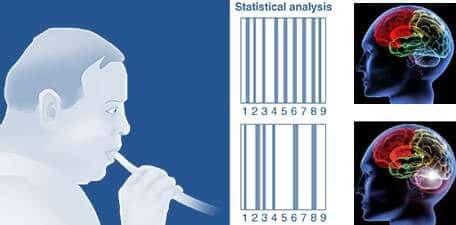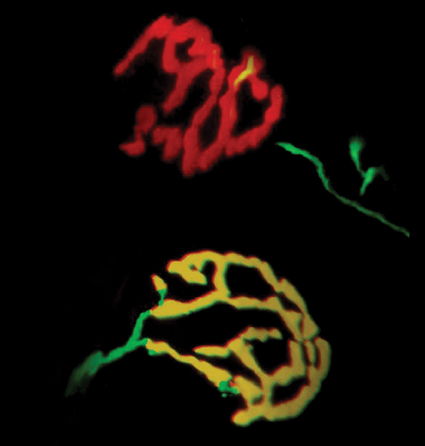Researchers from the University of Rochester in New York succeeded in producing cells from which the body produces the myelin cells that are damaged in diseases such as multiple sclerosis and other neurological diseases from induced skin cells

A study published on February 7 in the journal Stem Cell shows that human brain cells created by reprogramming skin cells are highly effective in treating myelin disorders, a family of diseases that includes multiple sclerosis and a rare childhood disease known as pediatric leukodystrophies.
The study, according to its editors, is the first successful attempt to produce a population of cells critical to neural signaling in the brain from induced pluripotent stem cells. In this case, the researchers used cells extracted from human skin and transplanted it into animals that serve as a model for myelin diseases.
"The study supports the ability of induced stem cells as an effective and possible source of cells for the treatment of myelin disorders, says the researcher from the University of Rochester Medical Center, the neurologist Stephen Goldman, the principal investigator. "In fact, cells derived from this source appear to be at least as effective as those generated from embryonic stem cells."
The discovery opened the door to new induced stem cell treatments for a variety of neurological diseases characterized by the loss of a specific population of cells in the central nervous system, called myelin. Like the insulation in electrical wires, myelin is a fatty tissue that insulates the connection between nerve cells and ensures the smooth transmission of signals from one cell to another. When the myelin tissue is damaged, communication between cells is disrupted or even lost.
The most famous disease associated with a myelin disorder is multiple sclerosis, in which the body's own immune system attacks and destroys the myelin. The loss of myelin is also the focus of a series of fatal diseases known as pediatric leukodystrophies that attack children. While personally it is a rare disease, cumulatively thousands of children are diagnosed with it every year around the world.

The source of the myelin cells is in the brain and in the spine is a type of cells called oligodendrocytes (oligodendrocytes) oligodendrocytes, in turn, are descendants of other cells called oligodendrocyte precursor cells or OPC.
Myelin disorders have long been considered a target for cell-based therapy. According to the theory, if healthy OPC cells could be transplanted into the sick or injured brain, then these cells might be able to produce new oligodendrocytes capable of restoring the lost myelin, thus reversing the damage caused by the diseases.
However, there are several obstacles that need to be overcome. One challenge is that the OPC is a mature cell in the central nervous system and appears late in development. "Compared to nerves, which are among the first cells formed in human development, there are many stages and many steps required to create the glial cells such as the OPC" says Goldman. "This process requires an understanding of the basic biology and the normal development of these cells, and only then will we be able to reproduce this exact sequence in the laboratory."
Another big challenge was identifying the ideal source for these cells. Most researchers in the field focused on cells derived from embryonic stem cells and specialized tissue cells. While the researchers who will use these cells have produced vital insight into the biology of stem cells, these sources are not considered ideal to meet the demand when cell-based healing becomes more common.
The discovery in 2007 that skin cells can be reprogrammed to the point where they return to a biological state equivalent to embryonic stem cells - cells called induced stem cells - represents a new path forward for scientists. Since these cells, which are created from the patient's own skin cells - are genetically adapted to the patient, the likelihood of transplant rejection decreases significantly. These cells also ensure an endless source of material from which the cells needed for healing can be derived.
Goldman's team was the first to successfully master the complex process of using induced stem cells to produce OPCs. This process takes a long time. It took Goldman and his team four years to locate the signaling chemical required to program, produce and ultimately purify OPC cells in a significant quantity to be transplanted into the experimental animals, and each such preparation required almost six months from the skin cell stage to transplanting a population of pre-myelin cells.
Once they succeeded in identifying and producing OPCs from induced cells, they developed the ability of these cells to build new myelin cells when they were transplanted into mice with hereditary leukodystrophy, which deprives them of the ability to produce myelin.
They found that the OPC cells spread throughout the brain and begin to produce myelin. They observed that OPC cells derived from induced stem cells do this more quickly, easily and efficiently than cells derived from embryonic tissue. The animals were also free of any cancerous growths, a potentially dangerous side effect of some stem cell therapies, and they also survived longer than mice with the same diseases who did not receive treatment.
"The new population of the OPC and the oligodendrocytes was dense, widespread and intact" says Goldman. "In fact, the myelin restoration process seems to be faster and more efficient than from all other cell sources."
The next step in the evaluation of these cells - clinical trials may be soon. Goldman, along with a team of researchers and clinicians from Rochester, Syracuse and Buffalo are ready to begin OTC treatment for MS patients. This group, known as the Upstate MS Consortium, received approval for funding from the New York State Stem Cell Science Council. While the consortium's initial research – the first phase of which should begin in 2015 – will focus on cells derived from tissue sources, Goldman expects that OPC cells derived from induced stem cells will eventually be included in this project.

6 תגובות
Hello, I read the article very carefully and with some kind of excitement. I would like to know where the research stands today. Is it possible to restore damaged myelin in humans? And why is it not mentioned that trigeminal neuralgia patients can also win recovery and return to a new life. I would appreciate a response. Jewish girl.
I fell ill in Guyana 18 years ago and was left with many mobility disabilities
As a result of severe myelin damage.
I am already 63.5 years old and I am not sure that I will be able to enjoy the fruits of this study.
But even if so, and they succeed in restoring my myelin, is it possible after such a period?
Long to restore my muscles, some of which have completely atrophied?
If it is possible to restore brain cells, why don't they begin to restore brain cells in people suffering from various brain diseases?